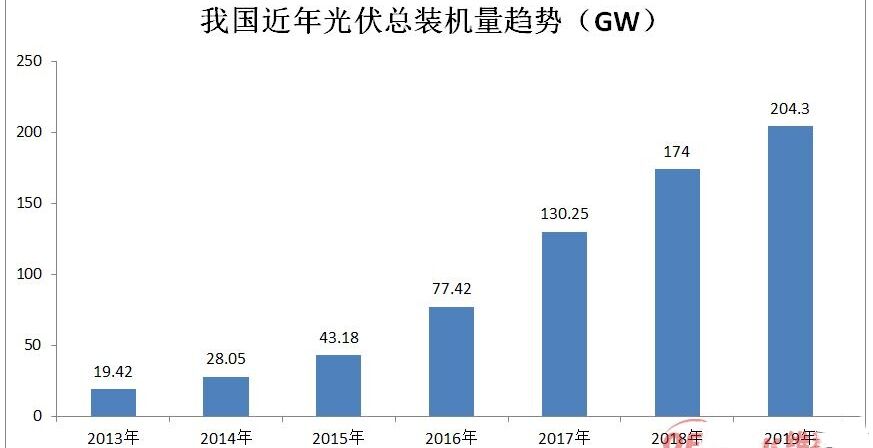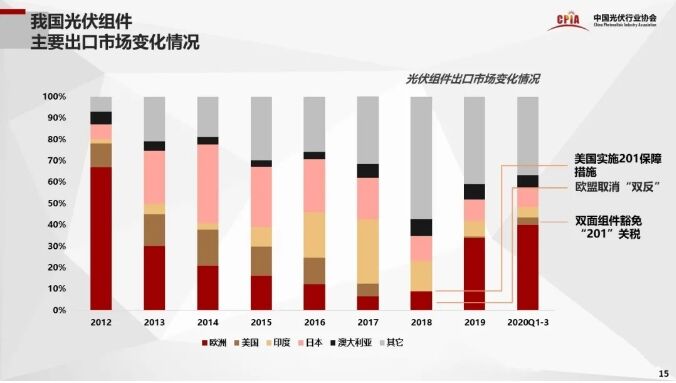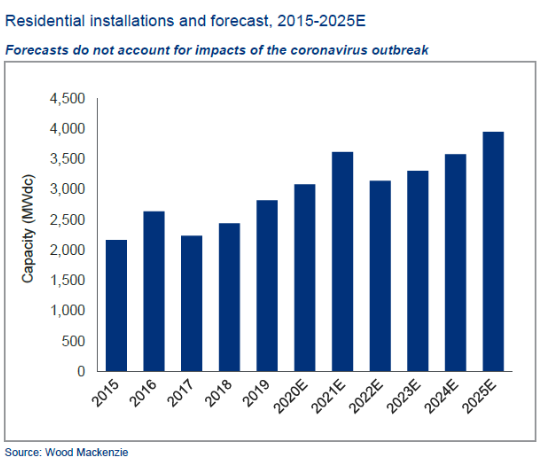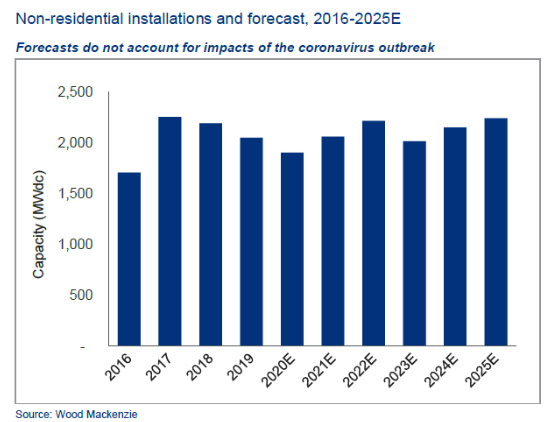On December 12, 2020, General Secretary Xi Jinping announced in his important speech entitled “Continuing the past and opening up a new journey to a global response to climate change”: By 2030, China’s carbon dioxide emissions per unit of GDP will drop by more than 65% compared with 2005. Non-fossil energy will account for about 25% of primary energy consumption, forest accumulation will increase by 6 billion cubic meters compared with 2005, and the total installed capacity of wind power and solar power will reach more than 1.2 billion kilowatts.
On December 13, Biden, one of the US presidential candidates, stated on social media that he would rejoin the Paris Agreement 39 days later, the first day of his inauguration, and is committed to making the United States achieve greenhouse gas emissions by 2050. “zero emission”. This is consistent with Biden’s previous campaign statement that after he is elected US president, he will allocate US$2 trillion to strengthen the country’s clean energy infrastructure and reduce its dependence on fossil fuels.
The leaders of China and the United States have spoken out and will vigorously support the development of renewable energy development. This is a major benefit of renewable energy in the world, and photovoltaics, the fastest-declining power generation cost in the past decade, is undoubtedly the key.
China’s PV Status
In the past few years, China’s photovoltaic industry has made brilliant achievements, and the total installed capacity ranks first in the world. As of the end of 2019, my country’s total photovoltaic installed capacity has reached 204.3GW, and the United States, which ranks second, has a cumulative installed capacity of only 62.298GW. Among them, most of China’s photovoltaic installations are from 2013 to the present, which shows how amazing the development of my country’s photovoltaic industry is.

According to data, as of the end of September 2020, the country’s cumulative installed wind power capacity was 220 million kilowatts, and photovoltaic power generation was 220 million kilowatts. The cumulative total was 440 million kilowatts. There is still a gap of 760 million kilowatts from the 1.2 billion kilowatt target.
If wind power and photovoltaic power generation each account for half, that is to say, in the decade from 2020 to 2030, the average annual new photovoltaic installations will be 38GW, which is much higher than the 30.1GW new photovoltaic installations in 2019. In comparison, photovoltaic power generation is more cost-effective than wind power. Therefore, the newly installed photovoltaic capacity will definitely be higher than 38GW.
For this goal, my country’s photovoltaic companies have long been prepared. Since 2020, many component companies are actively expanding production, putting into production or planning multiple raw material production bases. Some companies have also signed long-term contracts with upstream suppliers for several years to ensure future raw material supply. The market is confident.
Of course, in addition to the domestic market, many companies also set their sights on overseas markets and actively participate in the bidding of photovoltaic projects in other countries or regions. The accumulated advantages in technology and production capacity over the years are expected to be demonstrated in competition with other local companies.
China PV remain problems
For now, photovoltaic companies in developing countries have also encountered some problems when they “go to sea”. For example, policies have had a huge impact on photovoltaic companies in developing countries.

According to a recent report by Wang Bohua, vice chairman and secretary-general of the China Photovoltaic Industry Association, on the development review of the photovoltaic industry during the 13th Five-Year Plan period and the outlook for the 14th Five-Year Plan period, my country’s photovoltaic module exports in 2018 suffered a huge blow in the United States and EU The important reason is the 201 safeguard measures implemented by the United States and the EU’s “dual reverse”.
Although the export of components to Europe has resumed, we still cannot relax our vigilance. In the future, my country’s photovoltaic enterprises can follow the pace of development of the “One Belt One Road” and build photovoltaic projects in countries along the route to establish a good brand image.
Domestically, arrears in my country’s photovoltaic subsidies are also a problem, causing many companies to complain. The operation of photovoltaic power plants by enterprises would have contributed to the development of photovoltaics, but the arrears of subsidies have caused many companies to avoid photovoltaic power plants, especially private enterprises, whose financing costs are relatively high, and they can only sell their assets when they are delayed in receiving subsidies. Reduce debt.
GCL New Energy, which has repeatedly sold assets recently, is a representative enterprise. Fortunately, a state-owned enterprise or a central enterprise will take over, otherwise many power stations may fall into a state of unmanagement.
In addition, the large-scale development of photovoltaics is mainly to replace conventional energy, and the absorption capacity is very important. Therefore, when the installed capacity of photovoltaics continues to explode, attention must be paid to the subsequent consumption problems, and local consumption is the main focus, otherwise long-distance power transmission and transformation will reduce the cost advantage of photovoltaic power generation.
In terms of research and development, the large-scale mass production of leading companies will certainly help reduce costs, but under the pressure of performance, it may also cause them to misjudge the technological development trend and be overtaken by other countries. Therefore, even if the leading enterprises have sufficient advantages, they must support the technological innovation of small and medium-sized enterprises and colleges to ensure my country’s leading advantage in the photovoltaic industry.
American Photovoltaics
As a major energy-consuming country and the country with the highest GDP in the world, the return of the United States to the “Paris Agreement” is of great significance to the development of global renewable energy. In 2019, under the turmoil of withdrawing from the “Paris Agreement”, the newly installed photovoltaic capacity of the United States still reached 13.3GW, which shows its profound foundation and strength.
According to Wood Mackenzie’s prediction, household photovoltaics in the United States will see a substantial increase in 2020-2025, which is mainly due to consumption differences. High-end consumers in the United States seem to prefer suburban single-family houses rather than the development of household photovoltaics It will be relatively stable.
Although the two figures did not take into account the outbreak of the new crown epidemic, they also did not take into account Biden’s 2 trillion renewable energy support plan, so it will be a relatively accurate figure, and it may even exceed this expectation.


Image Credit: Wood Mackenzie
As a leading country in scientific research and technology, large-scale capital investment is likely to allow the United States to make breakthroughs in some key technologies, or even leap-forward breakthroughs, such as the conversion efficiency of solar panels.
You should know that Tesla, the world’s highest market value car company, not only sells new energy vehicles, but also has an in-depth layout in solar cells and clean energy storage. Many of the super charging stations built in the United States come from photovoltaic power generation, and there are also better solutions for household photovoltaics, which may be a dark horse in the photovoltaic field in the future.
Potential opportunity
However, if any industry wants to develop rapidly, the most important thing is cost. If the US relaxes its trade policy, it will be a great opportunity for Chinese photovoltaic companies to enter the US market.
After the rapid decline in photovoltaic module prices, the next step is to enter thousands of households. Therefore, the future of distributed photovoltaic is the focus of development, which can accelerate the popularization of photovoltaics and solve the problem of consumption.
However, compared with centralized photovoltaics, the former has higher customization and installation requirements, and the later operation and maintenance costs are slightly higher. At the same time, the scale is relatively small. How to balance rapid growth and cost is a matter for China and the United States. Common problems in photovoltaic development.
China and the United States have voiced in concert that the vigorous development of renewable energy is undoubtedly a major benefit to photovoltaics, and I believe that it can help the two countries achieve the goal of carbon neutrality as soon as possible and promote the development of global “green energy“.



 2020-12-17
2020-12-17


















